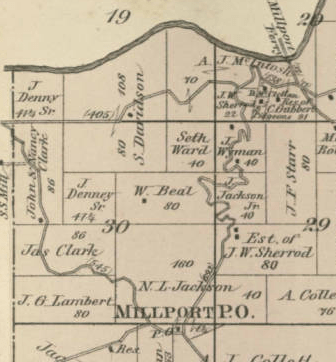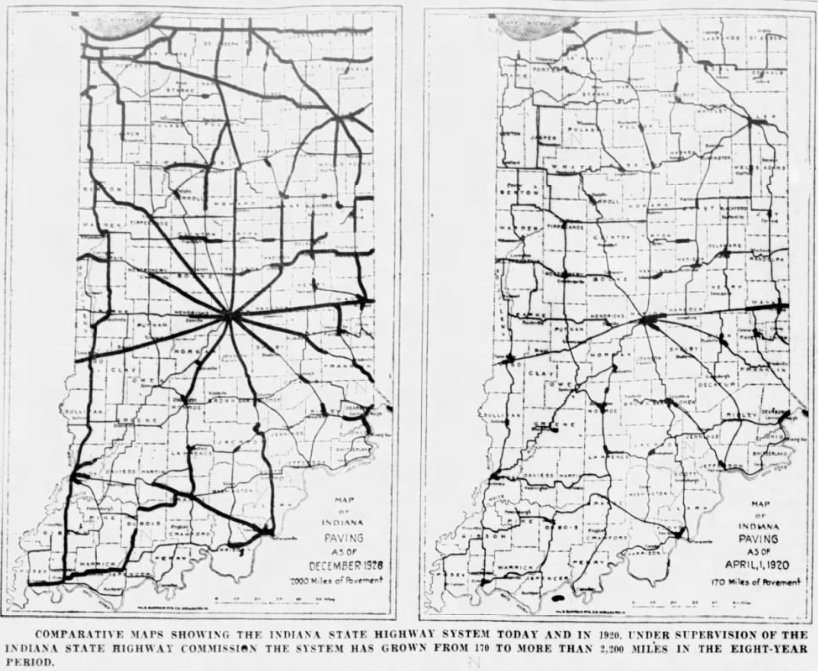Today, I want to look at a railroad that started in Northern Indiana, but would ultimately stretch as far as Rushville…or maybe Shelbyville…but I’ll get to that later.
The subject railroad started life as two different railroads. First was the Grand Rapids, Wabash & Cincinnati Railroad, created under the laws of Indiana on 29 September 1869. The plan was to build a railroad from Grand Rapids toward Indiana, likely at Goshen. This railroad never built any track.
The second railroad, which the GRW&C would merge with on 30 June 1870, was the Warsaw, Goshen and White Pigeon Railroad. The WG&WP would be authorized by the Indiana General Assembly on 11 February 1870. That railroad would build a 24 mile line in 1870 between Goshen and Warsaw.
The two railroads above would merge to become the Cincinnati, Wabash & Michigan Railway on 30 June 1871. This would allow the already built line between Goshen and Warsaw to be extended to Anderson over the next five years. The line reached North Manchester, 19 miles from Warsaw, in 1871. The next year, 1872, 16 miles of rail were put in service from North Manchester to Wabash. The next year, Marion was reached with the construction of another 19 miles.
The line continued southward with a 10 mile connection to Fairmont in 1875 and the next 23 miles to Anderson in 1876.
Collectively, the line was commonly referred to as the “White Pigeon” road. The road itself would fall on hard times, as was typical of Indiana railroads of the era. Meanwhile, in Michigan, a new railroad was chartered. The Elkhart, Niles and Lake Michigan Railroad was created by the State of Michigan on 19 July 1880. This company would build a railroad from Niles, Michigan, to the Indiana State Line north of Granger, a total of 10 miles, in 1882.
This was the same that the new Cincinnati, Wabash & Michigan Railway would build a line to connect to the EN&LM at the state line to Goshen. This added 20 miles of track to the CW&M.
Then, on 11 August 1882, the Elkhart, Niles & Lake Michigan merged into the Cincinnati, Wabash & Michigan, taking the latter name. This, with the continued construction at the northern end of the railroad, left the CW&M with a track that stretched from Anderson, Indiana, to Benton Harbor, Michigan, by the end of 1882.
And then things got interesting.
In 1883, it was announced that the White Pigeon Road would be building a subsidiary road to connect Anderson to Rushville. This line would carry train traffic through Knightstown and Carthage to Rushville. At this point, other than the Panhandle route going east to west, Knightstown had no other rail connections. Also, at Rushville, through other connections, the CW&M could actually carry traffic to Cincinnati.
But the owners of the CW&M saw another prospect. As was typical at the time, railroads weren’t built, usually, in such direct lines. The old phrase “money talks” was very much alive and well in the late 19th Century. The owners of the CW&M saw a chance to make even more money, contributing to the construction of a railroad, if they pitted two towns against one another. They chose Shelbyville.
The Hancock Democrat of 20 August 1883 dedicated over two full columns to the prospect. The plan was to incorporate a railroad to be called the Anderson, Greenfield and Shelbyville Railroad. It would be owned by the CW&M. There were even talks that Rushville was taken completely out of the running for the extension.
And the residents of Rush County were less than enthused.
The Hancock Democrat was reporting both sides of the issue. It was, however, beneficial to the Democrat, and its readers, should the railroad come through Greenfield.
The line wasn’t completed until 1891…and it ended at Rushville. Here, the line connected to the Vernon, Greensburg & Rushville, a line that had been leased by the Big Four in October 1891. At the same time, the Cincinnati, Wabash & Michigan would also be purchased by the Big Four.
But even that was not as tidy a proposition as one would assume. This was after the announcement in July 1890 that the Lake Shore & Michigan Southern (New York Central) had acquired the complete Cincinnati, Wabash & Michigan. This was strange in that the LS&MS owned one-quarter of the CW&M stock. Another one quarter was owned by the Big Four. Most of the last half of the stock was owned by a railroad President named D. J. Mackey. He was the President of the Big Four. Mackey had purchased the stock from J. H. Wade, President of the CW&M, in 1889.
While the CW&M belonged to the Big Four, and was planned to be completely merged at the close of the fiscal year on 30 June 1892, it wasn’t until 16 June 1915 that the line actually became officially part of the Big Four. It had been called the Michigan Division of the latter railway, but on paper, it was still separate.
There are still vestiges of the old CW&M that exist to this day. The original line from Goshen to Anderson is still shown on maps. It is owned by the Norfolk Southern. Past Anderson, however, while the track still exists in some places, it has long been out of service. Knightstown used to be home to the Carthage, Knightstown & Shirley Railroad, connecting those three towns. It was used as an excursion railroad for many years, until it was closed by its owner, Tom Allison, in 2013.











































